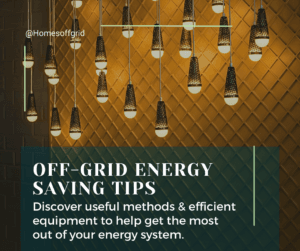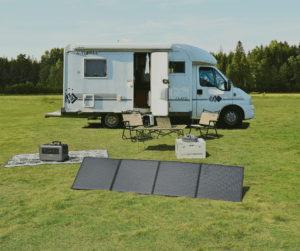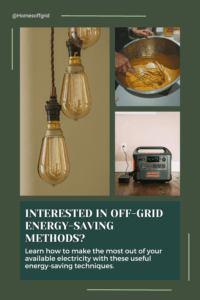Energy saving when living off-grid is essential to make the most of every ray of sunshine, every gust of wind, and every drop of stored power. Living disconnected from the grid brings freedom and self-reliance, but it also demands a heightened awareness of your energy use. Without a solid strategy, even the best renewable setup can falter when the days grow short, or the breezes die down.
Sizing your system to meet your needs is the first step, yet budget or site constraints often mean you must start small. Practising energy consciousness bridges the gap – timing high-draw tasks for midday solar peaks, batch-processing chores when renewable output is highest, and favouring manual tools over electric alternatives wherever possible. Seasonal shifts, from weaker winter sun to calmer skies for turbines, underscore the need for redundancy: spare panels, extra batteries or a portable generator can smooth out shortfalls and keep your lights on.
Discover how to assess your off-grid energy needs, choose efficient appliances, and adopt behavioural strategies that save power without sacrificing comfort. Learn low-tech tricks – from solar ovens to rocket stoves – plus smart storage and monitoring techniques that ensure your system stays efficient today and tomorrow.

The Importance of Saving Energy When Living Off-Grid
Even the simplest off-grid home needs a basic energy setup. Unless you remove all electrical devices – from your fridge to your mobile phone – you’ll require power generation and energy storage. A bare-bones solar panel and battery bank can keep essential appliances running, but every additional device increases demand.
Sizing your system to perfectly match your needs is ideal, yet budgetary and site constraints often force compromises. In these cases, energy consciousness becomes your most valuable tool. Adopt energy-saving habits and consider energy-efficient equipment to reduce strain on your system. Small changes can free up precious watt-hours for heavier loads.
Seasonal shifts have a dramatic impact on renewable output. Winter brings shorter days and weaker sun; calmer weather means wind turbines may sit idle. During these lean months, consumption must be carefully managed, especially if you have a limited system. Tracking your daily generation and adjusting usage patterns accordingly helps avoid unexpected blackouts.
Redundancy smooths out energy shortfalls. A handful of extra solar panels, an oversized battery bank, or a compact generator provides a safety net when renewables falter. Even a small portable power station can bridge gaps during extended cloudy periods. By combining suitably-sized equipment with mindful energy use and backup systems, you’ll ensure a reliable power supply, whatever the situation.
Assessing Your Off-Grid Energy Needs
Before implementing any energy-saving measures, you must understand your power requirements. The most accurate way to do this is to calculate daily and peak loads. List every appliance and its wattage – LED lighting, refrigeration, water pumps, and device chargers. Multiply each device’s power draw by the hours of use to estimate daily consumption. Remember that some appliances, like a fridge or freezer, cycle on and off, so factor in average run-times rather than continuous operation.
Next, decide on a ‘right-sized’ system versus one built for future growth. Off-grid electrical installations can be costly, so starting with a basic array and battery bank may suit limited budgets. If your energy needs increase – perhaps adding a workshop or larger freezer – you can expand later. Plan cable routes and mounting points now to simplify future upgrades.
Building redundancy into your design will smooth out periods of low renewable output. Consider spare solar panels, extra battery capacity, or a small portable generator. Even a compact power station can bridge gaps during extended cloudy or windless spells.
Finally, weigh the benefits of 12 V or 24 V DC systems against mains-level supply. Lower-voltage circuits minimise inverter losses and run many appliances directly. Yet some devices – washing machines or kitchen appliances – require a true mains connection. A hybrid system, with a smaller inverter and a dedicated 12 or 24 V circuit for lights and electronics, often delivers the best balance between efficiency and convenience.
Choosing Energy-Efficient Equipment
Selecting energy-efficient equipment reduces demand on your off-grid system and extends autonomy. Small investments in the right appliances can deliver large savings over time.
Modern LED bulbs use a fraction of the power drawn by halogen or incandescent lamps. Choose 12 V or 24 V DC models where possible to avoid inverter losses. Similarly, Energy Star-rated refrigerators and freezers consume significantly less electricity than older units. A well-insulated, small-footprint fridge can cut energy use by half.
Opt for low-power electronics wherever you can. A laptop typically draws less than half the power of a desktop PC. Low-voltage USB chargers and power banks let you replenish devices with minimal waste. Hand-powered tools – such as manual coffee grinders, hand drills, or foot-pump blenders – can replace small electric gadgets without compromising functionality.
Swapping electric kitchen and personal-care appliances for manual versions is surprisingly effective. A sturdy whisk beats an electric mixer for most recipes. Air drying instead of using a hair dryer or other heat-based styling tools will save a substantial amount of energy. Meanwhile, a good-quality toothbrush saves the power you’d spend charging an electric model.
Finally, choosing efficient cooking and heating appliances can make a big difference. Insulated wood-burners retain heat longer and require less fuel. Slow cookers and pressure cookers concentrate heat into food, cutting down on full-power cooking time and energy use. A well-maintained masonry stove can also warm your home with a single daily load of wood instead of utilising electric heating options.

Behavioural Strategies and Load Shifting
Behavioural strategies and load shifting help off-grid households match consumption to renewable generation. By altering daily routines, you can use energy when it is most abundant and avoid costly shortages. These energy-saving changes will make living off-grid more efficient, and more comfortable in the long run.
- Timing high-draw activities is key to off-grid efficiency. Schedule device charging for midday peaks when solar output is highest. During these windows, charge power banks and run essential equipment.
- Batch-process chores such as laundry, water pumping, and power tools rather than running them sporadically. Avoid half-load washes and reduce cycle temperatures for energy savings. Ditch the tumble dryer – hang laundry outside, in a drying room or near a wood burner.
- Kettles can be a hidden drain; use a whistling stove-top kettle instead. Pour unused boiled water into a thermal flask to save future reheating.
- Efficient showers also matter when water pumps demand power to run. Turn the taps off when you don’t need them running like when you’re soaping up. Consider washing hair less often or using a flannel wash to conserve both energy and water.
- Fridges and freezers run constantly; check temperature settings regularly for optimum efficiency. A full freezer uses less energy than one half filled.
- Track consumption with simple meter readings or a manual logbook to identify waste.
- Unplug electronics and turn off lights when not in use.
These small habits compound into significant energy savings over time.
Improving Thermal Performance
Effective thermal performance is one of the easiest energy-saving methods when living in an off-grid home. Start by ensuring solid insulation and thorough draught-proofing. Insulating walls, roofs, windows and doors reduces heat loss and keeps warmth inside. In older buildings, adding insulation to the roof space and walls can halve heating requirements. Draught excluders on doors, sealant around windows and even simple brush strips beneath exterior doors make a significant difference.
Passive solar heating harnesses the sun’s warmth without extra energy input. If you are in the building stage or have a portable home, position south-facing windows to capture sunlight in winter. You can also use thermal mass, such as stone floors or a Trombe wall (a dark wall layer behind a glass layer used to absorb thermal energy in the air gap) to store heat. As the sun moves around, these materials absorb warmth by day and release it at night, moderating temperature swings naturally.
Seasonal textiles add another layer of protection. Heavy curtains over south-facing glazing trap residual heat after sunset, while rugs insulate cold floors underfoot. Removable insulated boards or panels can be used to cover hard-to-reach skylights in winter, then can be stowed away when warmer weather arrives. These practical measures not only save energy but also enhance comfort throughout the year.
Smart Storage and Backup Solutions
Building a modular battery bank allows you to expand your system as budget and needs evolve. Start with a core set of batteries – typically deep-cycle AGM, gel, or lithium-ion units – and design your layout so you can add cells later. Ensuring all batteries share the same capacity and age prevents imbalance. A 24 V system, for instance, may require fewer parallel strings than a 12 V setup, reducing wiring complexity and inverter losses. If your energy demands grow you can simply slot in extra batteries, avoiding the upfront cost of a fully sized system.
Portable power banks offer a flexible, hands-on approach to energy saving in off-grid living. When your main array is generating peak solar or wind power, top up small batteries for devices like phones, tablets, or LED lamps. This practice frees larger battery banks for heavy loads – pumps, refrigerators, or power tools – during evenings or cloudy spells. A routine of charging portable units during midday helps safeguard essential communications or lighting, should your main bank dip below critical levels.
Thermal storage provides an ingenious ‘solar dump’ to soak up excess renewable energy. Solar-heated water tanks, equipped with insulated jackets, can store heat for space or water heating well into the night. Phase-change materials (PCMs) – wax or salt mixtures that absorb and release heat at a fixed temperature – can be integrated into walls or floor panels to smooth out temperature swings. By diverting surplus electricity to heat water or PCM units once batteries are full, you not only save energy but also enhance comfort without relying on grid power or extra fuel.

Optimising Renewable Generation
Maximising the output of your renewable systems is vital for energy saving in off-grid living. Solar panels perform best when kept clean and angled correctly. Dust, pollen, and bird droppings can reduce output by up to 25%. Regularly wash panels with fresh water and a soft brush, and inspect for damage. If possible, adjust the tilt seasonally – steeper in winter, flatter in summer – to capture the sun’s lower arc or avoid midday overheating. Position arrays away from shade caused by overhanging trees or buildings, as even small shadows can significantly drop power production.
Portable and adjustable solar arrays offer flexibility for nomadic or evolving setups. Mounting panels on tilting brackets or portable frames means you can chase the sun during the day. Solar trackers automatically follow sunlight, boosting yield by up to 40% compared to fixed panels. While trackers add cost and mechanical complexity, they can be worthwhile where space is limited or peak output is essential. For DIY enthusiasts, simple manual trackers on hinges can be built from spare timber or metal. On the other hand, newer solar panels are generally much more efficient with larger solar catchment capabilities so tilting panels may be an unnecessary extra task.
Micro-wind turbines complement solar power, particularly in exposed or breezy locations. Install turbines on tall masts or ridge tops to catch steadier, less turbulent winds. Even small turbines with 500–1000 W capacity can recharge batteries overnight or during overcast periods when solar is inactive. Regularly check blades for damage and ensure the mounting remains secure. Combining wind and solar generation smooths out supply gaps and reinforces your system’s resilience, keeping your off-grid home powered in all conditions.
Low-Tech and Ingenious Energy Savers
When striving for energy saving in off-grid living, sometimes the simplest tools make the biggest impact. A solar oven harnesses free sunlight to cook stews or bake bread without drawing a single watt. Likewise, solar dehydrators capture sun and airflow to preserve fruit, vegetables or herbs, turning surplus produce into long-lasting snacks with minimal electricity.
For heating, rocket stoves and masonry heaters burn small amounts of wood at very high efficiency. Rocket stoves concentrate combustion in an insulated chimney, meaning less fuel and far less smoke. Masonry heaters store heat in a heavy mass of brick or stone, releasing warmth slowly over many hours from a single fire. Both designs offer a low-tech route to reducing reliance on electric or gas heating.
Roof-based measures can also save power by moderating indoor temperatures. Reflective roof paints deflect solar radiation, keeping lofts and upper rooms cooler in summer. This can be extremely useful if you have roof-mounted bi-facial solar panels as they can utilise the reflected solar radiation. Green roofs planted with sedum or wildflowers absorb rain, provide insulation and lower heat gain. These solutions cut both cooling and heating demands, complementing more high-tech renewables in your overall off-grid energy strategy.
Maintenance, Monitoring and Continuous Improvement
A robust energy-saving regime rests on regular maintenance. Schedule checks of solar panels, charge controllers, cabling and battery health at least twice a year. Clean PV panels and inspect connections for corrosion or wear. Replace any damaged wiring or connectors promptly to avoid hidden losses.
Monitoring tools help spot inefficiencies before they become serious. Simple data loggers or smartphone apps can track generation, storage and consumption in real time. Reviewing export and import patterns reveals under-used capacity or unexpected drains. Armed with this information, you can trim unnecessary loads and optimise usage habits.
Continuous improvement ensures your off-grid system keeps pace with changing needs. Plan for gradual upgrades – swap ageing batteries for higher-capacity or more efficient models when the time is right. Transition to the latest LED lighting or low-power appliances as budgets allow. Incremental enhancements compound over time, keeping your home both comfortable and lean on energy.
Conclusion
Combining a suitably-sized energy system with mindful habits is the most practical method for saving energy when living off-grid. A setup that meets your daily requirements, backed up by spare panels, batteries or a small generator, gives you the capacity you need. However, it is your everyday choices – timing high-draw tasks for solar peaks, batch-processing chores, and favouring manual tools over electric ones – that keep your system running smoothly when resources are tight.
Small behavioural and technical tweaks accumulate into significant savings. Simple measures – unplugging devices when not in use, defrosting your freezer regularly, or installing heavy curtains – add up over months and years. Low-tech solutions such as solar ovens, rocket stoves and reflective roof coatings complement high-tech upgrades like modular battery banks and micro-wind turbines, creating a resilient, efficient home.
To master off-grid energy saving, start with a thorough audit of your current system. Track incoming energy, storage and consumption with simple logbooks or data-logging tools. Apply the tips in this guide one at a time, monitor the impact, and adjust your approach as you learn. Over time, these practical steps accumulate, saving you energy and giving you a reliable, efficient off-grid home.

To find out more about off-grid living return to our Reading Room.


